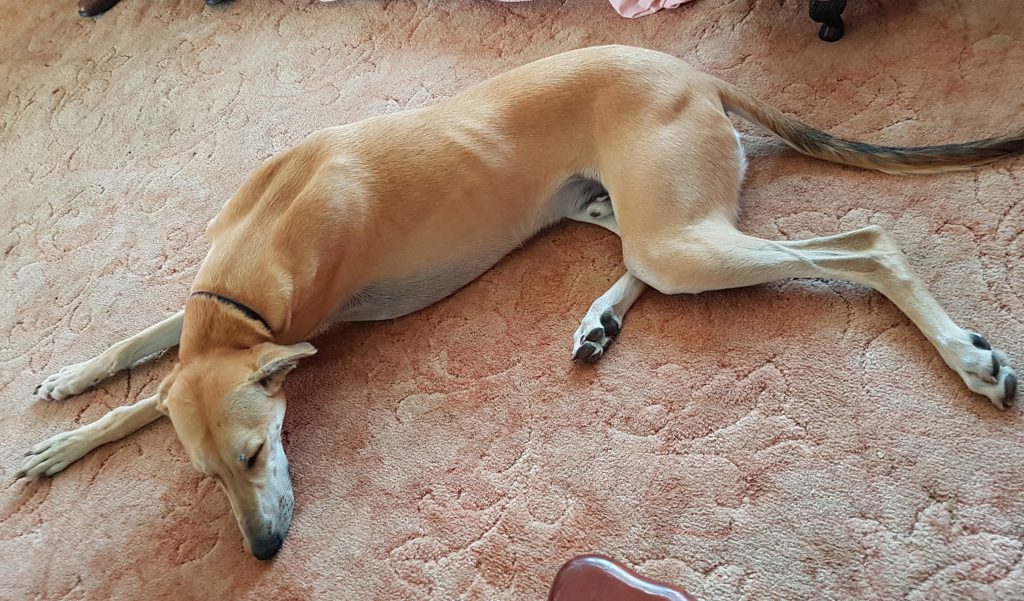Lurcher Rufus is a wonderful dog whose only problems are as a result of over-arousal. He then redirects frustration, using his teeth.
The two-year-old had been picked up, abandoned, eight months ago and has settled into his new life beautifully.
A lovely, friendly dog, he’s confident and curious. Rufus can get very excited when he sees people. He was unusually calm when I arrived – but I didn’t fire him up! He sniffed me thoroughly and gave me a little ‘kiss’ in the ear. I began to respond with some attention and he quickly became excited. I felt his mouth on my hand.
His lady and gentleman are finding it hard to stop him mouthing their hands and their arms – sometimes quite roughly. The more aroused he becomes, the rougher he gets.
Rufus redirects frustration using his teeth.
If he’s not getting attention, he will demand it using his mouth. If he is thwarted or ignored, he redirects frustration using his teeth.
The biggest problem however is cats! Their house is surrounded by cats that seem hell-bent on winding up Rufus. He may be controllable past one or two, but by the time he’s encountered the third that may be waiting in his drive as they arrive back home from a walk, his chase instinct is in full gear.
The other day when he lunged at a cat, his lady owner held on as tightly as she could. Rufus’ head swung round and she received a nasty bite on her arm.
Holding on tightly with a harness that tightens as he pulls may save the day at the time, but isn’t a way to change the behaviour of a dog that redirects frustration onto you. The frustration itself has to be addressed and this takes time. The people themselves must be able to get and hold their dog’s attention, taking action before he gets anywhere near this state of arousal.
This is easy to say, but not always so easy to put into practice.
Better equipment will give better control.
The first thing they will do is to get a harness where a longer lead can hook both front and back. They will then have more control in emergency and the dog will be more comfortable. Then they should keep those walks near home where they may encounter cats very short indeed to avoid ‘trigger stacking’. This is where his stress and excitement builds up until he explodes and he redirects frustration onto the person holding the short lead.
Instead of being held tight, the dog actually needs to feel free while they work on their own relevance and teaching him behaviours that are incompatible with lunging at cats.
This work will start at home. There should be no more reinforcement of any kind for the rather excessive and uncomfortable mouthing which is quite obviously a habit and his default when aroused. You could say that he’s ‘mouth happy’. The more stressed he becomes, the harder the grip with his teeth. I don’t like to call this a bite.
When it happens they need to be immediate. They recognise the signs. Even as his mouth approaches they must withdraw themselves and look away. No more scolding or ‘No’. Currently when they may leave their hand in his mouth before removing it. They need to change their own habits and respond a lot more promptly.
It must be hard being a dog, having no hands, only mouth and teeth!
It looks like Rufus generates much of his attention by mouthing or bringing toys to throw or tug. The man has a nasty bite on his thumb he received while playing with him – it was a mistake. Rufus has not learnt to be careful with his teeth. From now onwards all play instantly stops if teeth or even open mouth are felt.
The tuggy game played properly is a great way to teach this.
Just as important is to regularly offer him plenty of interaction when he’s calm. Already his humans they have started hunting nose-games games with him.
Although he has bitten a few times, I would never label Rufus an ‘aggressive dog‘. A dog that redirects frustration is a dog that is unfulfilled. In Rufus’ case, when out, it’s his drive to chase that’s unfulfilled.
They will get a long line so Rufus can have a degree of freedom when they take him by car to more interesting places where he can sniff and explore. Chase and recall can be worked on too. Always restrained on a short lead must in itself be frustrating for him.
They have strategies now to help Rufus to calm himself down and they know how to handle the mouthing. Communication with humans must be frustrating for a dog too – with no hands and with no language that humans seem able to understand!
He must gradually learn that it’s times he’s not using his mouth that things happen. It’s not always a good idea to ‘let sleeping dogs lie’ if there is nothing in it for them!
Like charity, impulse control starts at home. Over time and with work, they should be able to manage the cat situation too.




